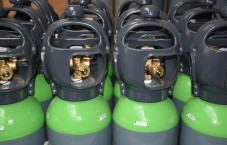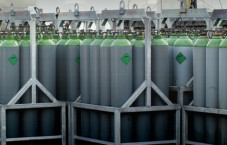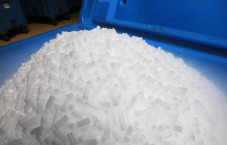Emergency cooling with CO₂

When there is a power failure or maintenance work needs to be performed to refrigerating equipment, it is of course important to continue to cool the stored goods. Liquid CO2 or dry ice (CO2 in solid form) offers a cheap and quick solution.
Application scope
For frozen foods the maintenance of the cold chain is essential. Once thawed, the food has of course no longer any value. That is why it is important with maintenance work on or in the event of a power failure of the refrigerating installation to have sufficient emergency cooling.
Requirements
Liquid CO2, decompressed to a pressure lower than 5 bar, converts to dry ice and gaseous CO2. The cooling capacity mainly happens in the sublimation heat of the dry ice (approximately 600 kJ per kg dry ice). By removing this energy from the stored products, they retain their cold and they can be preserved in good condition.
For a lossless storage of liquid CO2, IJsfabriek Strombeek can make cylinders available with dip tube (or for larger installations batteries with dip tube). This cooling technique ensures that you as a customer always have the necessary cooling available. Our team of engineers is ready to give you technical advice with the installation.
After every use, the cylinders or framework must of course be exchanged to ensure that with a subsequent failure or maintenance work sufficient cold-capacities are available.
Dry ice is CO2 in solid form and can be used for emergency cooling.
If possible, the dry ice is placed at the bottom of the freezer counter, on top of this, a sheet of cardboard (to avoid direct contact with the extreme cold) and on top of this frozen food.
This method also allows you to carry out maintenance or replacement work to the refrigerating equipment without jeopardising the quality of the stored products.
IJsfabriek Strombeek always has sufficient dry ice in stock to make a rapid intervention possible.
Advantages
For both cooling techniques, the following benefits apply:
- easy to use
- the extremely cold and stable temperature of -78,5 °C
- the gas released (CO2) is approximately 1.5 times heavier than air whereby the surroundings remain bacteria and germ-free
- leaves no residue
- CO2 is an approved additive
Delivery Forms
IJsfabriek Strombeek can deliver liquid CO2 in various formats, both in separate cylinders as well as in batteries. You can also contact us for dry ice in polystyrene boxes (10 and 30 kg), in insulated boxes (250 and 400 kg) or plastic bags (10 kg).



